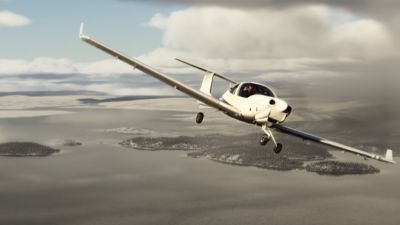
Diamond DA40-NG for MSFS 2024: Authentic Training & Free Upgrades
Developer COWS brings the Diamond DA40-NG to MSFS 2020 and 2024, showcasing precise flight dynamics, custom circuit breakers, and an…
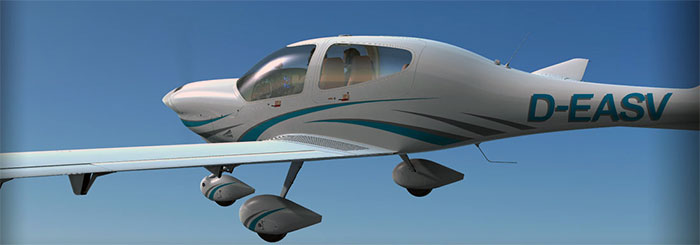
The DA40 Star is a light, single-engine, low-wing, composite aircraft designed and manufactured by Diamond Aircraft of Austria. First flown in 1997, it is a four-seat expansion of the earlier DA20. Manufactured in Austria and Canada, it is popular with flying schools and militaries around the world for flight training.

Its official airworthiness certification is for normal and utility categories. Both categories are limited to airplanes that have a seating configuration of nine or fewer excluding pilot seats and a maximum certificated takeoff weight of 12,500 pounds or less. Aerobatic operations are certified under the utility category but not under the normal category.
Overall dimensions are similar to the FSX Cessna 172 Skyhawk, but it is slightly heavier and faster. Its low wing, T tail, and svelte shape distinguish it from other light aircraft and enable easy identification at any airport.
The following specifications were obtained from the Diamond Aircraft website, which says "Performance specifications may vary depending on model and equipment selected." All figures are rounded, approximate, or typical as appropriate.
Alabeo has produced a sharp rendition of Diamond's DA40 with high-definition textures, accurate features inside and outside, realistic behavior, among other touted features. Versions are available for FSX and P3D. I reviewed the FSX version.
Five liveries in stylish modern designs are provided, including one of multiple bright colors. I found similar designs among the many DA40 liveries I found on the Internet. It also provides one plain white aircraft for custom painting. Designs remain crisp and clear even in close-up views.
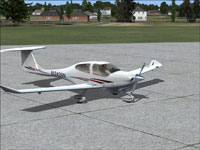
N2428N |

N1113E |
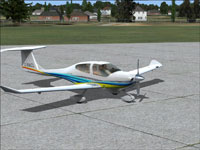
G-RACL |
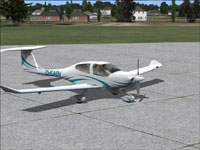
D-EASV |
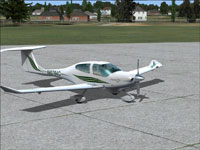
N8784C |
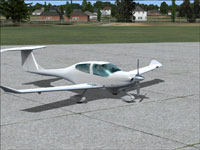
Plain White |
Exteriors of Alabeo's DA40s are true to the real-world photos I found on the Internet, including sizes, dimensions, and details. Physical details such as air-intake vents, door latches, antenna, flaps fairings, and seams between the molded-composite forms are all depicted accurately. Surfaces are smooth and reflective consistent with the real-world aircraft's composite materials. Reflections of the world around the aircraft, such as clouds and ground features are clearly visible, and they change as the aircraft's attitudes and surroundings change. Shading effects and light-source shines change as the aircraft's attitudes change.

N2428N |
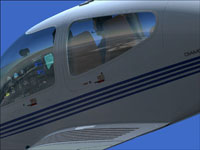
N1113E |
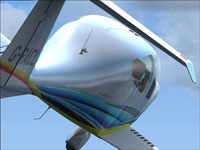
G-RACL |

D-EASV |
Wheel fairings can be "installed" and removed through a check box on a popup window.
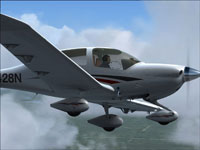
With Wheel Fairings |

Without Wheel Fairings |
Alabeo paid as much or more attention to detail inside the aircraft as seen outside. Carpeting, upholstery, lights, air vents, seat belts, handles, and other hardware are all shown with utmost clarity close up and from a distance. The seat textures look as though they might be part leather and part fabric. As with outside, the cabin's lighting effects are realistic with light sources and shadows depicted accurately. The spaciousness of this small aircraft's cabin is obvious from the interior scans. Charts and other papers in the side pockets make the cockpit looked lived in. Night lighting is realistic. Interiors are the same for all six liveries.
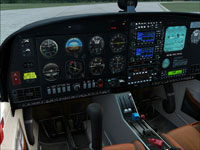 |
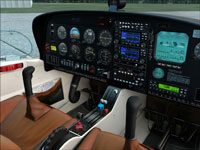 |
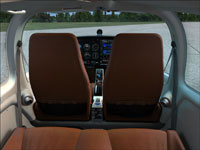 |
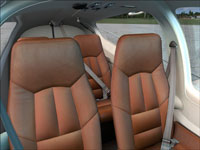 |
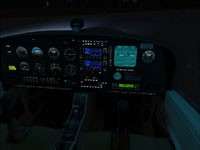 |
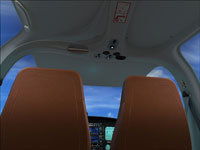 |
Through a checkbox in a popup window, users may select a transparent windscreen or a regular windscreen. The latter is slightly cloudy but barely enough to notice a difference. Both windscreen versions have scratches.
Alabeo's DA40 rendition depicts the traditional analog instruments powered by air pressure, gyroscopes, and electricity, which was common in early models of Diamond's DA40. (Diamond curiously used one electronic "glass" instrument to show engine and electrical data and another to show fuel levels in its old panels.)
All scales, needles, and text in Alabeo's instruments are easy to read from where the eyes of a pilot would be. Most text on the panel surface and and on major controls are crisp, clear, and easy to read from a normal distance, but some require zooming in. This is particularly true of the electrical switches and flaps lever. By clicking all around the cockpit and all over the main instrument panel, I found that most switches, buttons, knobs, and levers worked. Night lighting is realistic with backlighting of the instruments and spot lighting of the controls.
Alabeo uses a Vision Microsystems VM 1000 for its electronic engine monitoring system. It shows manifold pressure, engine speed, engine temperatures, fuel flow, and other significant data. Its dials and digital readouts are clear and easy to read from the pilot's eyes. Some of its buttons below the screen affect the display, and others do nothing.
The two Garmin GNS 430 GPS devices are commonly installed in Alabeo aircraft and should therefore be familiar to users of Alabeo's aircraft. Their display screens are about half the size of the Garmin 500 GPS devices used by MSFS , which is the most obvious difference. Additionally, they handle the communication and radio frequencies, thus eliminating the need for separate radios. Otherwise, they perform the same functions as the Garmin 500. A larger version is displayed in a popup window. Alabeo enables FSX users to replace its stock GNS 430s with units from Reality XP, which is explained in its manuals. Alabeo clearly states that this feature is not available for P3D.
The Bendix/King KFC 225 autopilot looks much like the Bendix/King autopilots used in default MSFS general-aviation aircraft, but it functions a little differently. The most significant difference I found is that it must be given a vertical speed or it will not climb or descend, whereas the default MSFS Bendix/King autopilot automatically knows a vertical speed and climbs or descends immediately. Alabeo says in its manual that it modified or eliminated some features of the real-world KFC 225 autopilot features "to have a simpler instrument suitable for the simulator."
A placard says the DA40 is certified for IFR and day-and-night VFR. The analog panel has all the required IFR instruments.
No two-dimensional panel is included. Some flight simmers like them, and some never use them.
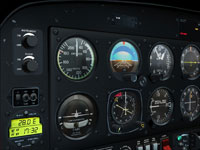 |
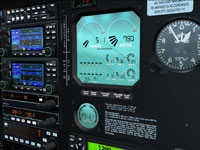 |
 |
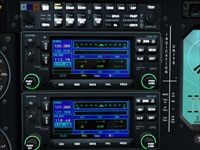 |
Lenses on the instrument windows can be made to appear or disappear though a checkbox in a popup window. The most visible differences are that the instruments are either bright and clear as though they had no lenses or slightly foggy to depict lenses. Reflections on these lenses are visible whenever the aircraft's light source and/or attitude change.
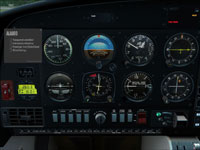
Glass Reflections |

No Glass Reflections |
Pilots and flight simmers who prefer glass cockpits refer to analog instruments as "steam gauges," which is a pejorative term reflecting their disdain for what they consider outmoded. Some pilots and flight simmers strongly prefer glass over analog, and some don't care one way or another. I am among the latter. The Diamond Aircraft website advertises glass cockpits for its currently produced models, and one reviewer criticizes Alabeo for depicting this out-of-production model. In response to my question, Alabeo said: "Our decisions about which aircraft we'll model are based on many factors, including customer suggestions and others." It has been producing modern and vintage add-on aircraft for years, so its rendering an out-of-production DA40 should surprise no one.
To create sounds unique to Diamond's DA40, Alabeo uses 27 WAV sound files and one unique DLL file that must be accepted by the users whenever the aircraft is loaded for the first time in a simulator session. Having never flown in a real-world DA40, I cannot personally attest to the realism of these sounds, but they seem accurate for an aircraft of this type. I have no reason to doubt Alabeo's authenticity, either.
| Sound Examples Click to Listen |
||
|---|---|---|
|
Startup |
RPM1 |
BEE |
Alabeo provides six PDF documents enabling users to maximize their enjoyment of its DA40:
GNS 430 User Guide: This three-page manual uses text and annotated screen shots to explain the uses of this Garmin GPS device. Most flight simmers who have used other Alabeo aircraft will be familiar with this device.
Autopilot KFC225: Alabeo's three-page manual explains all functions of its modified KFC 225 autopilot with annotated screen shots and text.
Normal Procedures: This 26-page manual is a series of checklists for all flight phases from preflight to post-flight inspections. Like most checklists, many of its steps are ambiguous, so cross referencing with the reference and performance data is required.
Emergency Procedures: This 28-page, all-text manual provides guidance for a multitude of emergencies such as engine problems, defective controls, smoke/fire, and emergency landings.
Performance Tables: This three-page document provides two pages of tabular data about power measures such as propeller RPM, manifold pressure, and fuel flow at various altitudes. One page contains a table showing true airspeeds attainable at various power settings and altitudes.
References: This two-page document shows four significant V speeds and describes the four color markings on the airspeed indicator.
Alabeo curiously does not include a manual for its Vision Microsystems VM 1000 electronic engine display. I found one for the real-world model at the Lexington Flying Club.
Regarding performance, Alabeo's SimShack product description says only that behavior is realistic. Its aircraft are usually true to their real-world counterparts, however.
I tested Alabeo's Diamond DA40 at London International/Municipal Airport (CYXU) in London, Ontario, Canada (about halfway between Toronto and Detroit). That is where Diamond Canada builds its DA40s, and its factory is clearly seen in Google's street views. Elevation is 912 feet (278 meters), and its longest runway is 8,800 feet (2,682 meters). I used standard atmosphere and the aircraft's default weight.
Weight and Balance: According to the FSX Fuel/Payload menu, Alabeo's Diamond DA40s weigh 2,247 pounds (1,019 kilograms), which is 85 percent of its 2,646-pound (1,200-kilogram) maximum take-off weight. This weight consists of two persons at 180 pounds (82 kilograms) each plus 41 US gallons (247 pounds, 112 kilograms) of fuel, which is 100-percent capacity.
Taxiing: Alabeo's DA40 taxis like similar light aircraft. It accelerates with slight power increases, it turns nicely at normal taxiing speeds, and it stops where needed with reduced power and braking. I found nothing difficult about taxiing in this aircraft.
Taking Off: The Pre-take-off checklist says to deflect flaps to the T/O position, which is one notch. The Take-off checklist says to advance power fully but not abruptly to a "high RPM." Whatever is high enough or too high is not clear, so I advanced throttle fully and saw the tachometer reach 2,700 RPMs, which is within the yellow caution zone but below the red maximum line. The checklist says the nose wheel should lift off at 59 knots and the aircraft should climb off the runway at 60 knots to 67 knots depending on weight (more weight requires higher speed and vice versa). My DA40 accelerated quickly, rotated at 60 knots, and lifted off the runway at 65 knots, all of which is consistent with the checklist guidance.
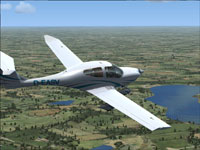
D-EASV |
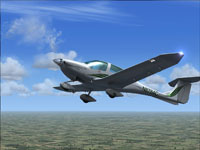
N8784C |
Climbing: The Climb checklist says to set engine speed at 2,400 RPMs when "above safe height." Above safe height is an ambiguous term that generally means the aircraft is definitely climbing and will remain airborne. The Cruise Climb checklist says maximum power, 2,400 RPM, and rich fuel mixture. It also says "flaps up," but it doesn't specify an airspeed or altitude. I retracted them after attaining my "above safe height." I found nothing about best climb speed or angle.
My DA40 had no trouble climbing at 70 knots indicated airspeed, 1,000 feet per minute with a 10-degree pitch and flaps up. After I lowered the pitch to 5 degrees, vertical speed fell to 500 FPM and airspeed accelerated to 95 knots. After the aircraft stabilized in its climb, airspeed rose to 105 knots, and vertical speed rose back to 1,000 FPM. The Climb Cruise checklist calls for adjusting mixture to hold EGT steady. Neither leaning nor enriching the fuel mixture moved EGT from 1,120 until the engine sputtered from overleaning, then EGT went under 1,000. So I followed the AOPA guidelines for leaning mixture throughout my climb to cruise altitude, which is basically leaning until the engine sputters, then enriching until it resumes normal operation, and doing this every 2,000 feet of climb.
The aircraft struggled to climb to its specified ceiling of 16,400 feet (5,002 meters). From about 11,000 feet (3,355 meters), I had to advance engine power to the maximum RPMs of 2,700 by pushing throttle and propeller to their maximums. The Climb and Cruise Climb checklist guidance of 2,400 RPMs is not enough power to reach service ceiling.
Cruising: The DA40 cruised nicely at 16,000 feet (4,880 meters). After I fiddled with the throttle, propeller, and mixture controls to achieve the numbers in Alabeo's tables, the aircraft steadied at 95 knots indicated, which computes roughly to about 127 knots true airspeed. This speed is considerably slower than the specified 150 knots at 75-percent power. Neither indicated nor true airspeed is identified in the specifications, but neither 95 nor 127 is close anyway. I tried this twice more with only slightly better results.
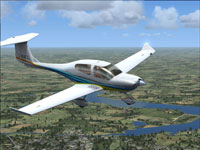
G-RACL |
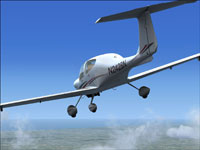
N2824N |
Descending: Descending requires simply adjusting power, pitch, propeller, and mixture as needed to achieve the performance numbers in Alabeo's tables. The DA40 descended smoothly at 100 to 110 knots indicated during my descent to approach altitude.
Approaching: The Approach checklist says to reduce speed to 108 knots indicated to enable flaps deflection. This was easy because the aircraft wasn't traveling much faster than that anyway. For the final approach, the checklist calls for flaps in the T/O position, which is one notch down, and for fully rich fuel mixture and high RPM power. With those factors stabilized, simple throttle adjustment enabled the recommended airspeed.
Landing: Alabeo's checklists don't include one for landing, so I "winged" it based on the Approach and Before Landing checklists and my experience. They call for flaps in the LDG position (third notch) and approach speeds between 58 knots and 73 knots depending on weight (more weight, more speed, and vice versa). So with the aircraft in the approach configuration and given my aircraft's current weight, I "finaled" at 65 knots, flared at 55 knots, and settled down at 45 knots. The aircraft stopped soon enough with mild braking.
Aggressive Maneuvers: In subsequent flight tests, I forced the aircraft to excesses to find its limits. A barrel roll was not doable. It rolled slowly and went into a dive that cost me about 2,000 feet (610 meters) before I recovered. A loop was doable, but not nicely. I looped after diving to gain airspeed, but the aircraft didn't seem cooperative. I have no idea how much stress the airframe suffered during these maneuvers. Although the real-world DA40's utility certification could be interpreted as allowing aerobatics for this aircraft, a placard on the instrument panel plainly states: "All aerobatic maneuvers including spinning are prohibited."
Stalls: I tested stalls during take-offs and landings with the aircraft in the recommended configurations. My DA40 stalled at 42 knots whether it was under full power and pitched too high while climbing or whether at low power and pitched too high during final approach. Recoveries were quick by pitching down in the first case and powering up in the second, but the low-power, low-altitude stall was a bit scary as the tree tops whizzed past my windows.
Torque: The DA40 banked and pulled persistently to the right at all speeds, pitches, and altitudes throughout my flight tests. I don't know how much of this is attributable to prop wash, propeller torque, or P factor, but continual corrections to hold it straight were so distracting and the lack of rudder trim frustrated me so much that I felt forced to engage the autopilot. In response to my question, Alabeo said the real-world aircraft has no rudder trim either.
Overall: Alabeo's DA40 handles very easily in all flight phases on the ground and in the air with the exception of the torque condition described above. Having never flown a real-world DA40, I cannot attest to the accuracy of Alabeo's flight modeling, but it performed consistently with most of the specifications.
All significant cabin controls and handles and outside surfaces needed for flight are animated.
By using the standard FSX keyboard commands, I found that the front canopy hinges forward and the left side hinges outward like a gull wing. Nothing else moved when I tried other animation commands. Neither door opened or closed with mouse clicks on the interior handles, but the hatch windows on the left and right opened and closed with mouse clicks on their handles.
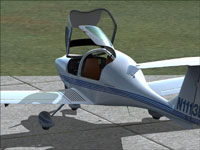
N1113E |
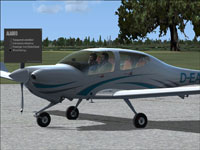
D-EASV |
Alabeo's Diamond DA40 is for FSX and P3D, and I reviewed the FSX version.
System requirements are typical, and this aircraft will probably perform well on most up-to-date flight simulators. It worked perfectly on my FSX with Windows 7. I cannot speak for older systems. Alabeo considerately shows minimum system requirements in its SimShack product description, which enables potential buyers can know in advance whether their systems can handle Alabeo's Diamond DA40.
The downloadable archive file is 211 megabytes, which is typical for an add-on aircraft, and it downloaded in less than one minute at cable-internet speed.
An installation program extracts the compressed files and installs them where they need to be in the simulator, making installation very easy for all users. A password is required. The process required less than one minute.
Required hard-drive space for the extracted files is 512 megabytes. Add 211 megabytes for the archive, and the total requirement is 723 megabytes.
Customer support is provided through a submission form on Alabeo's website. Alabeo asks users to check their knowledge base before submitting questions. (Many tech-support questions are already asked and answered). Readers having questions about this product should contact Alabeo because they are best able to explain their product.
In addition to Alabeo's typically high-quality visual and operative aircraft, its DA40 performance tables enable simulating real aircraft performance. Adjusting throttle, propeller, and mixture as necessary during climbs, cruises, and descents to achieve the parameters in the tables keeps us challenged and busy throughout most of our flight phases. No default MSFS aircraft provides these detailed performance parameters that real-world pilots use, and very few addons do either. The analog cockpit depicts DA40s manufactured before Diamond Aircraft made the glass cockpit its standard.
Upgrade Microsoft Flight Simulator, FSX, P3D & X-Plane in minutes with our curated file library packed with aircraft, scenery, liveries, and utilities.
Ready to upgrade your hangar?
Browse the free file library
0 comments
Leave a Response